A New Era of Challenge: Blizzard Confirms Ban on Real-Time Combat Addons in World of Warcraft: Midnight
Popular Now
 Free Fire
Free Fire
 Candy Crush Saga
Candy Crush Saga
 Free Fire Max
Free Fire Max
 BeamNG.drive
BeamNG.drive
 R.E.P.O
R.E.P.O
 Valorant
Valorant
 Warframe
Warframe
 Call of Duty
Call of Duty
 NBA 2K24
NBA 2K24
 Fortnite
Fortnite
 The landscape of high-level endgame content in World of Warcraft is poised for its most radical transformation in two decades. Blizzard Entertainment has officially confirmed that the upcoming expansion, Midnight, will introduce fundamental restrictions on the game’s API, effectively disabling the real-time combat functionality of iconic and long-essential addons such as Deadly Boss Mods (DBM) and certain combat-reactive configurations of WeakAuras. This decision marks a deliberate and controversial move by the development team to reassert control over encounter design, aiming to level the playing field and force players to rely on their own in-game awareness rather than third-party scripts. This change is scheduled to take effect as early as the Midnight Pre-Patch, setting the stage for a dramatic shift in how players approach Raid and Mythic+ Dungeon content.
The landscape of high-level endgame content in World of Warcraft is poised for its most radical transformation in two decades. Blizzard Entertainment has officially confirmed that the upcoming expansion, Midnight, will introduce fundamental restrictions on the game’s API, effectively disabling the real-time combat functionality of iconic and long-essential addons such as Deadly Boss Mods (DBM) and certain combat-reactive configurations of WeakAuras. This decision marks a deliberate and controversial move by the development team to reassert control over encounter design, aiming to level the playing field and force players to rely on their own in-game awareness rather than third-party scripts. This change is scheduled to take effect as early as the Midnight Pre-Patch, setting the stage for a dramatic shift in how players approach Raid and Mythic+ Dungeon content.
The announcement has sparked intense debate within the community, polarizing veterans and newer players alike. For years, DBM and BigWigs have been considered mandatory installations for any player serious about competitive content, providing audio and visual cues for complex boss mechanics, effectively “solving” encounters before they even begin. Blizzard’s new stance is not a total ban on all addons—UI customization, damage meters, quest helpers, and general visual enhancements will remain functional—but rather a precise, surgical restriction targeting tools that leverage real-time combat data for automated decision-making.
World of Warcraft: Midnight is shaping up to be a pivotal moment for the franchise, forcing a fundamental change in player skill and engagement. The era of scripted reactions is ending, and a new focus on base-game intuition and visual communication is beginning.
The Rationale: Ending the Encounter Design ‘Arms Race’
Game Director Ion Hazzikostas and other key developers have been transparent about the core motivation: the ongoing “arms race” between encounter designers and addon creators. As Raids and Mythic+ dungeons became increasingly mechanically dense, addons evolved to instantly parse and announce solutions, effectively trivializing the design intent. This cycle led to a higher barrier to entry, where players without these complex third-party tools felt severely disadvantaged, making them feel less like an optional enhancement and more like a required subscription.
 Blizzard’s solution is a technical one: implementing a “black box” around critical combat data. UX designer Crash Reed explained that the game will still allow addons to customize the user interface and display information about combat events (e.g., showing a cool-looking countdown), but the addon itself will be prevented from knowing the content or logic of that event in real-time. This restriction prevents the “problem-solving, real-time computation” that forms the backbone of DBM and combat WeakAuras.
Blizzard’s solution is a technical one: implementing a “black box” around critical combat data. UX designer Crash Reed explained that the game will still allow addons to customize the user interface and display information about combat events (e.g., showing a cool-looking countdown), but the addon itself will be prevented from knowing the content or logic of that event in real-time. This restriction prevents the “problem-solving, real-time computation” that forms the backbone of DBM and combat WeakAuras.
The ultimate goal, as stated by the development team, is not to increase the difficulty, but to “level the playing field” and shift the challenge back to the players’ coordination, communication, and moment-to-moment reactions. This is a massive MMORPG Gaming ecosystem shift that impacts everything from eSports (the Race to World First) to the casual raiding experience.
A New Paradigm for Combat: Design Changes in Midnight
To ensure content remains approachable without the aid of external timers, Blizzard is simultaneously overhauling its encounter design philosophy for the Midnight Expansion. Players can expect several key changes to boss fights and dungeons:
- Clearer Visual Telegraphs: Boss mechanics and hazardous effects will be significantly more distinct and visually obvious within the game world, making them easier to track without third-party alerts.
- Longer Reaction Windows: Group mechanics will be designed with slightly longer grace periods for player response, reducing the hyper-precision currently required by scripted WeakAura alerts.
- Reduction in Clutter: There will be a focus on reducing the number of random, simultaneous ground effects, especially for caster classes, allowing for greater spatial awareness.
- In-Game UI Replacements: Blizzard has committed to integrating native functionality to replace the most critical aspects of the removed addons. This includes an improved, built-in boss ability tracker (mimicking DBM’s timers) and enhanced systems for tracking personal cooldowns and buffs (a core function of WeakAuras).
The initial acid test for this new design will occur with a tuning pass to the most recent raid, Manaforge Omega, which will be adjusted to maintain an appropriate level of challenge once the API restrictions go live in the pre-patch. This proactive approach underscores Blizzard’s commitment to making the base game’s UI a viable and comprehensive tool for all tiers of play.
High CPC and SEO Keywords for Max Visibility
For those tracking this monumental WoW news update, the following high-value keywords are driving search interest and advertising revenue:
- World of Warcraft Midnight Release Date (High Search Volume, Purchase Intent)
- WoW Combat Addon Ban (High News Interest, Controversial Topic)
- Deadly Boss Mods Not Working (Troubleshooting & Information Search)
- WeakAuras Alternative (High CPC for new UI/Tool solutions)
- WoW Raid Guide Midnight (High Intent for New Content Strategies)
- Best WoW UI Addons 2026 (Post-change market for UI customization)
These terms, particularly those relating to the game’s API changes and new endgame systems, represent critical touchpoints for the Gaming Software and Digital Content markets. The elimination of long-standing external tools creates a new opportunity for Blizzard to sell a streamlined experience and for content creators to develop new guides for the “vanilla” challenge.
Beyond Combat: New Features in the Midnight Expansion
While the addon changes dominate the headlines, World of Warcraft: Midnight is bringing a wealth of new content to Azeroth, continuing the Worldsoul Saga narrative. This latest information, derived from recent deep-dive videos and developer Q&A sessions, highlights a renewed focus on player agency and old-world revival:
Player Housing and Social Hubs
The long-requested Player Housing system is finally making its debut. Players who pre-order the expansion will receive early access starting in early December. This is not a simple instanced room, but a fully customizable space—interiors and exteriors—with advanced options for resizing, rotating, and floating décor. This system is designed to be a permanent, core feature of the game, earning rewards through “Monthly Endeavors” tied to achievements, professions, and events.
Furthermore, a new neutral social hub, the Arcantina Tavern, is being introduced. Described as reminiscent of the gathering hubs in Monster Hunter World, it will serve as a sanctuary where Horde and Alliance players can socialize before venturing out to face the threats of the Void.
New Content and Class Adjustments
- Demon Hunter Third Specialization: The Vengeance and Havoc Demon Hunters are joined by the new Devourer specialization. This mid-range DPS spec is unique in that it forsakes traditional Fel energy in favor of the dark power of the Void, adding a new strategic layer to the class. Void Elves will also gain the ability to become Demon Hunters, expanding race-class availability.
- Delves & Companions: The popular Delves system from The War Within is returning, offering scalable, dungeon-like solo and small-group content. A new companion, the iconic Blood Elf Rogue Valeera Sanguinar, will aid players in these expeditions. Valeera can be assigned DPS, Tank, or Healer roles, complete with unique abilities like Vampiric Reaping for healing.
- World Revamp and New Zones: The expansion is set in a rebuilt Silvermoon City, which acts as a new shared hub, and a unified Eversong Woods zone. New zones like Harandar, a primordial jungle, and the chaotic Voidstorm realm will offer fresh environments to explore. The level cap will be raised to 90.
- The Prey System: An optional, difficulty-scaling bounty hunt system, Prey, will be introduced, offering Normal, Hard, and Nightmare difficulties for players seeking extra challenges and rewards in the open world.
The Impact on the World First Race and Competitive Play
The most immediate and dramatic effect of the combat addon restrictions will be felt by the world’s top raiding guilds competing in the Race to World First (RWF). These guilds have traditionally relied on highly sophisticated, custom-built WeakAuras and dedicated support staff to generate perfectly timed, scripted callouts for every nuance of a Mythic encounter. Removing this real-time API access means that a significant portion of their current strategy—the hyper-optimization of every second—will be nullified.
The future RWF will be far less about reading a third-party timer bar and more about:
- In-Game Visual Acuity: Teams will have to train their players to spot and react to Blizzard’s native visual and audio cues, putting a premium on pure in-game awareness and attention.
- Voice Coordination: The reliance on instant, verbal callouts and on-the-fly leadership will increase dramatically, making flawless communication a more critical factor than ever before.
- VOD Review and Manual Strategy: Post-fight analysis will become paramount. Teams will need to manually log and track ability cooldowns and cast sequences to build their own internal timer sheets, rather than having an addon automate it.
This seismic shift is an attempt to restore the prestige and core difficulty to World of Warcraft Raiding, ensuring that success is determined by mastery of the game client’s systems and group cohesion, rather than the efficiency of third-party software.
 Conclusion: An Unavoidable Evolution for the MMO Genre
Conclusion: An Unavoidable Evolution for the MMO Genre
The decision to disable DBM, WeakAuras, and similar combat-aiding tools in World of Warcraft: Midnight is a high-stakes gamble for Blizzard. It risks alienating a segment of the long-term player base who view these addons as integral to their play style, but it promises a healthier, more organic, and fairer endgame experience for the masses. By forcing players to engage with boss mechanics as they are designed—visually and temporally—Blizzard is attempting to break a two-decade-long dependence that, at times, made their own game feel incomplete.
As the Midnight Pre-Patch approaches, players must prepare not just for a new expansion and a rising level cap, but for a fundamental re-learning of core combat principles. The coming year will determine whether this dramatic restructuring of the MMO experience is the necessary course correction the game needs to thrive, or a controversial barrier that proves too much for the community to overcome. The foundation of high-level WoW Gameplay is being poured anew.









